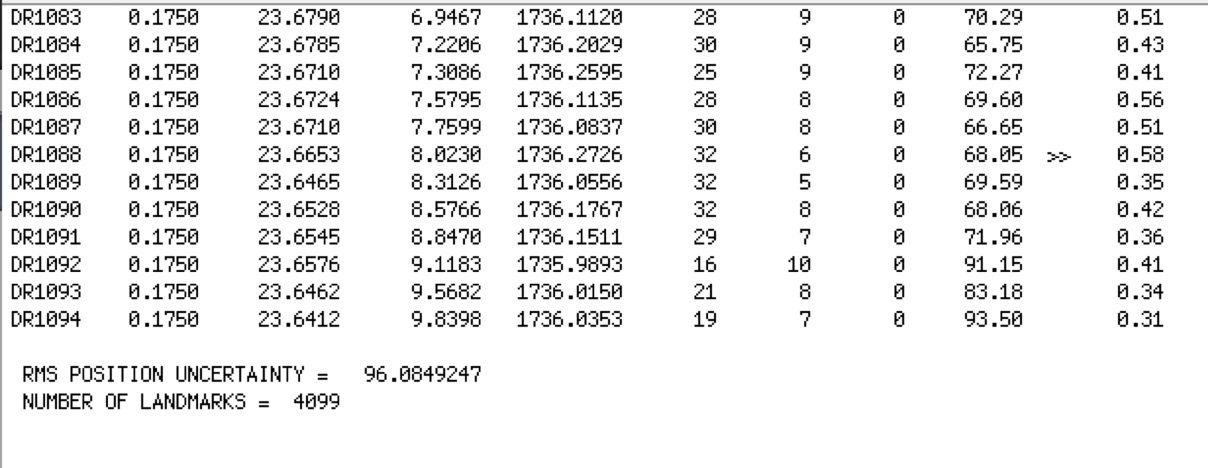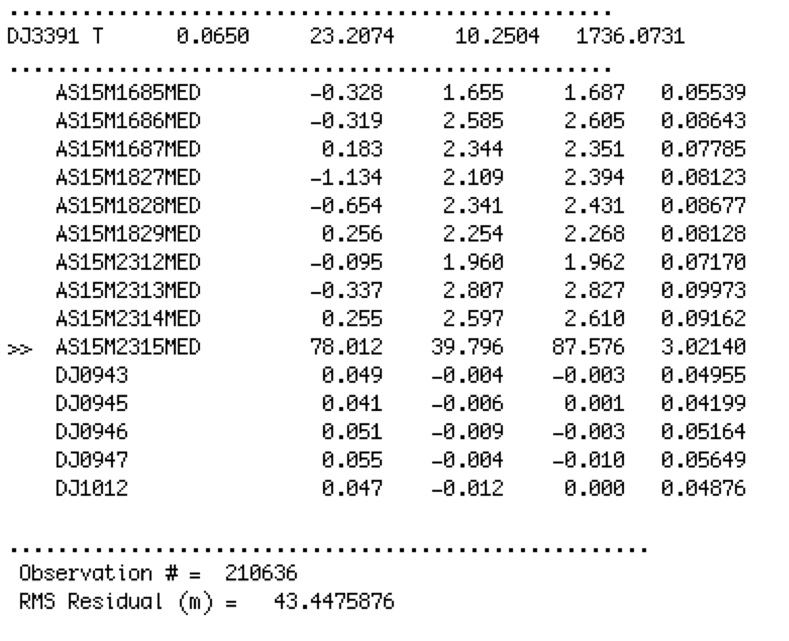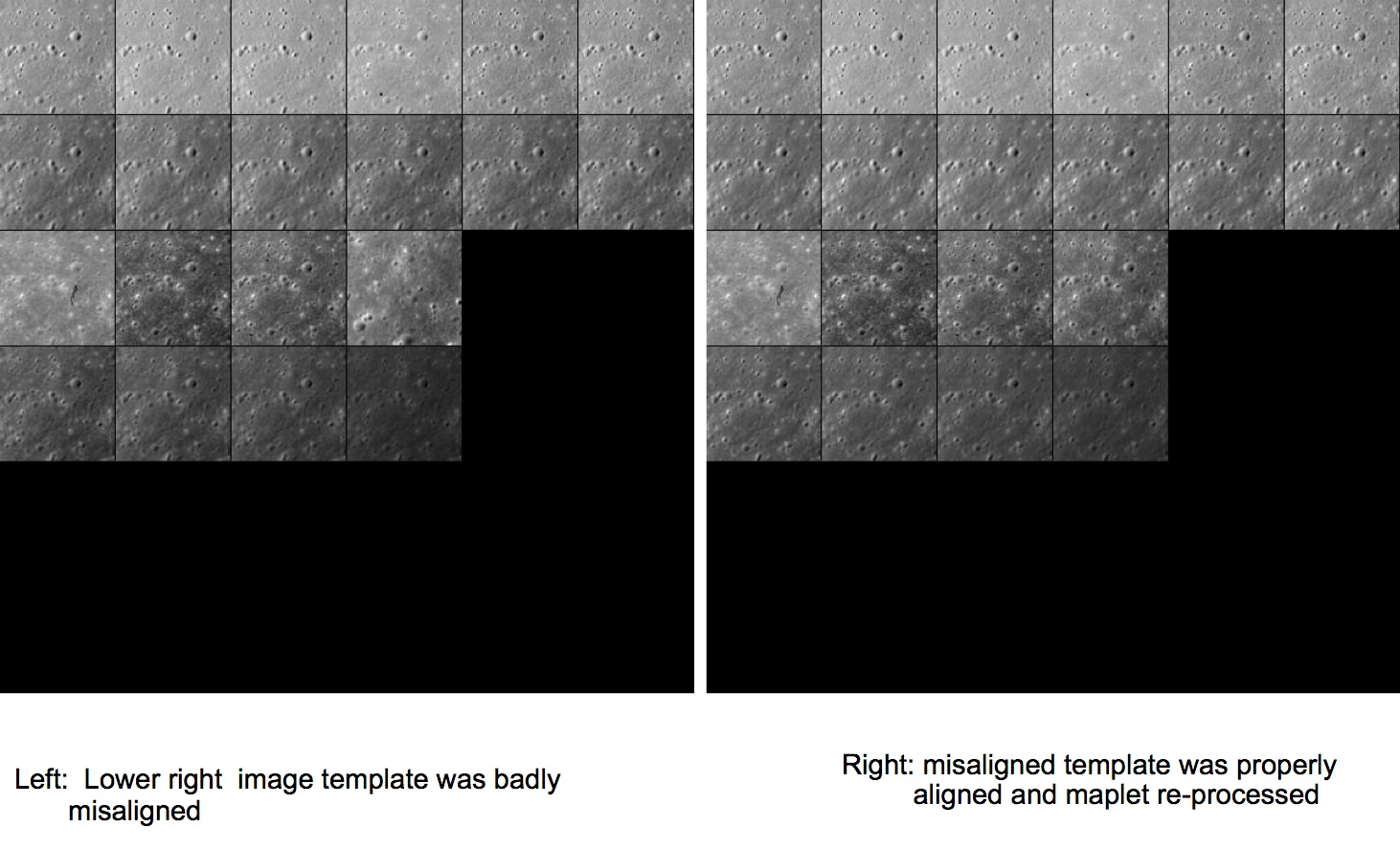residuals
Residuals tests the landmarks to look for problems. It will give you a report based on landmarks, pictures and maps.
Input - files
Input - stdin
- enter plim (px,km,km)
The number of pixels an image needs to be "off" (in maplet resolution?) to throw the chevron (>>) flag (in RESIDUALS.TXT)
- The standard deviation (that is allowed? ask EEP) of the center of each landmark (calculated by taking the vectors from the spacecraft to the center of a landmark; one vector per image in the landmark)
- Sets the "bin" size for the final histogram (basically how many images are in which categories). This histogram is found at the bottom of PICINFO.TXT. input operation list
2.5, 1, 001
Output
PowerPoint Notes
Description
- Compares predicted and observed pixel, line position of the landmarks in the images
- Produces RSS of the diagonal convariance elements of each control point
- Describes landmark position uncertainty
- Flags landmarks with residuals over specified pixel value
Control Points
- Inputs are weights for S/C uncertainties from measurement uncertainties and from a-prior shape constraints
Control points solution results in a 3x3 output covariance for each control point. Diagonal elements are uncertainties along maplet coord. system axes, i.e. two horizontal directions & height. Typically SPC produces comparable horizontal & height uncertainties. Results are summarized as a scalar standard deviation per degree of freedom in meters
- Residuals check automatically flags errors beyond certain input values in dump file for ease of inspection
Example

Image Residuals
- The post-fit residuals between predicted and actual control point positions in all images are captured in the residuals file
- The post-fit residuals between predicted and actual control point difference between adjacent, overlapping maplets are captured in the residuals file
- Outliers in both quantities are flagged automatically based on input threshold criteria
Example of a single landmark in RESIDUALS.TXT
- The 1st column is a list of 1. IMAGEFILES included in the landmark 2. overlaps with other landmarks 3. Limbs
- The 2nd column is the error in deltaX (# pixels in image resolution)
- The 3rd column is the error in deltaY (# pixels in image resolution)
- The 4th column is the magnitude of the error (combines deltaX and deltaY)
- The 5th column is the error in physical units (km)

Bad & Fixed Image

Qualitative Checks
- Qualitative checks are important to verify that the quantitative error estimates are believable
Render a single maplet, or a DEM synthesized by a collection of maplets, at the same geometry & illumination conditions as the images themselves
- Do all the features in the images appear in the DEM ?
- Are the smallest discernible features in the images, e.g., boulders, craters etc. visible in the DEM as well ?
- Is the relative albedo solution such that the relative brightness of adjacent image features matches that of the DEM ?
- Are the heights solution such that the length and overall appearance of the shadows in the DEM matches that of the image ?
How are Uncertainties Introduced in the Data
- Main types of uncertainties:
- S/C trajectory, camera pointing, image timestamp
- Manifest themselves mostly in the projection of image template onto the surface. Corrected by global geometry solution
- Image noise, artifacts, smear, overall image quality
- Manifest themselves in predicted image template brightness and in its fit to the extracted image brightness
- Photometric model and reflectance function models
Show up in slopes & heights integration
Poor choice of a-priori parameters & data weights
- Evident at end of each estimation step; data won’t fit well
- S/C trajectory, camera pointing, image timestamp
- Often above contributions are correlated; individual contributors may not be separated until many processing steps have been taken
